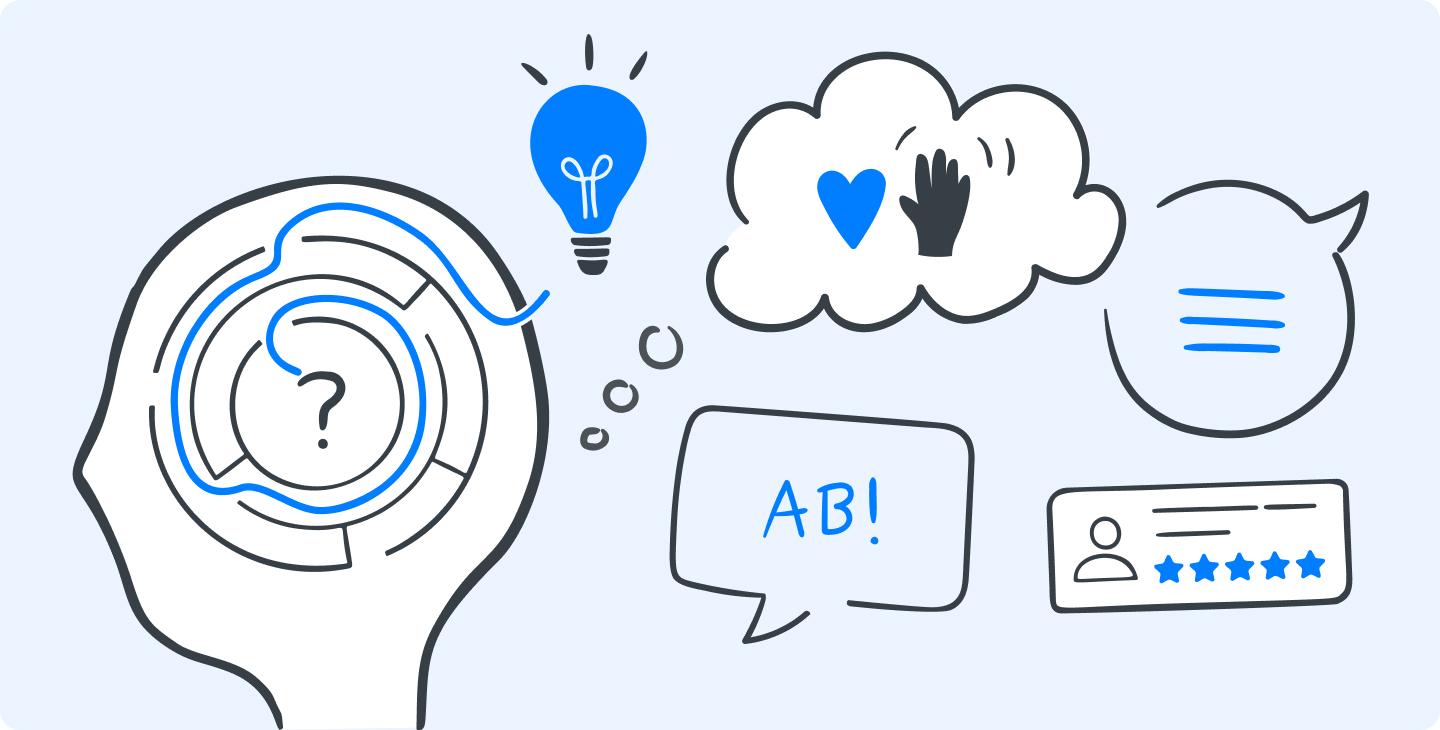Customer feedback is a popular topic across industries, and there are plenty of online resources that explain the ins and outs of feedback analysis. Some of this advice is confusing, outdated, or misleading. Beginners often find the information difficult to navigate; they get stuck on a specific topic (such as different feedback metrics), and they never learn how to use feedback to their best advantage.
This crash course is intended to be a comprehensive resource – something you can bookmark and return to if necessary. If you have any questions about feedback management, or you think we’ve missed something in our overview, please let us know via chat. We’d love to hear from you!
Why you should care about customer feedback
Customer satisfaction affects every aspect of your business. Satisfied customers stick with you, and reducing churn is the best way to increase your revenue.
- Keeping existing customers is cheaper than getting new ones
- Growth through word of mouth is the most efficient form of marketing
- Satisfied customers are more likely to recommend your business
“33% of Americans say they’ll consider switching companies after just a single instance of poor service.”
American 2017 Customer Service Barometer
“Investing in new customers is between 5 and 25 times more expensive than retaining existing ones.”
Invesp
Still, some companies gather feedback data and then leave it languishing in spreadsheets nobody ever uses. Or they let good information go to waste by interpreting it in an inflexible way.
Common mistakes in customer feedback analysis:
🥀 The rose-colored glasses approach, meaning that leaders focus too much on the positives and miss key warning signs.
🐜 Exclusive focus on individual agent/employee performance, without interrogating the holistic customer experience.
🌦 Infrequent feedback collection events that halt normal operations as employees scramble to process the influx of new data.
💀 Erratic, awkward interactions with customers. The most damning mistake to make here is letting unhappy customers feel ignored after they give feedback.
😵 Customers getting derailed in the process of sharing feedback. This might happen because they were asked leading questions, got overwhelmed by too many options, or because they found the survey to be unclear.
A surface-level look at the data will tell you if overall customer satisfaction stats are showing growth or a decline. But that’s not enough.
If you want to build a brand that lasts, multifaceted customer feedback has to be part of everything you do.
Complementary metrics: why you need both CSAT and NPS data
There are many different ways to keep your finger on the pulse of your user base. For example, you can use social listening tools to research how your brand’s being discussed in public spaces. To learn about the best ways to reduce inconvenience for your customers/users, it’s a good idea to employ CES (Customer Effort Score) surveys.
But regardless of your niche or the size of your company, there are two key metrics that – when used together – give you a fairly clear idea of your customers’ current sentiments and frustrations.
CSAT – Customer Satisfaction Score
CSAT surveys are popular for good reason. After you close a ticket, they give your customer the opportunity to rate their experience. CSAT questions are typically simple: you ask the customer if they’re happy with their interaction or purchase. They select their answers on a numerical scale, and they can also reply to open-ended questions if they like.
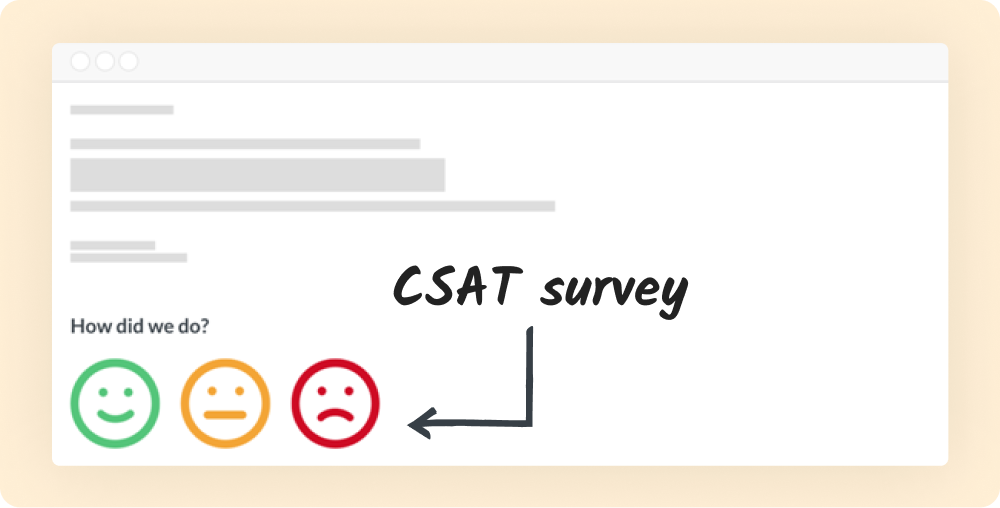
This gives you insights into specific aspects of the service you’re offering, including agent performance and the general reception of a new service. However, it isn’t enough for a comprehensive view of the customer experience.
In order to understand people’s day-to-day experience with your product or service, it’s helpful to poll them regularly. NPS is a great metric for that, and in our experience, it’s underutilized across industries.
NPS - Net Promoter Score
NPS surveys ask your customers how likely they are to recommend your company to others. You can send out NPS survey emails after releasing new products and services, but it’s also a good idea to collect annual or quarterly NPS feedback.
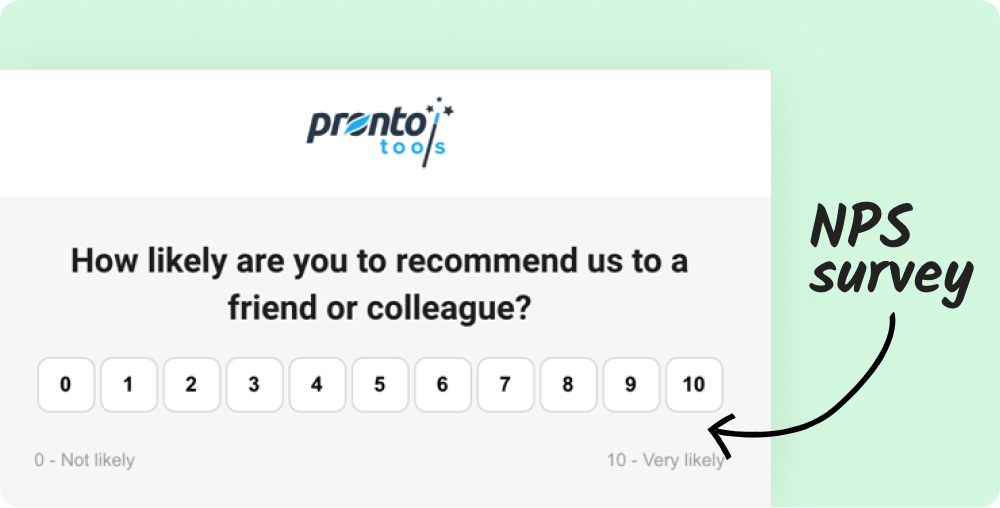
The two metrics together give you a good sense of the customers’ experience with your product or service.
For example, CSAT questionnaires give frustrated customers a good opportunity to pinpoint their issues and see them resolved within days. On the other hand, NPS surveys give you a chance to notice customer dissatisfaction before it grows into a reason for the customer to cancel their subscription.
How to leverage feedback to increase customer satisfaction and improve your internal operations
Fully-utilized customer feedback provides your company with direction and cohesion, on both a micro and a macro level.
Adopt the motto: “What’s measured, improves.” Every aspect of your operations needs to be based on – and motivated by – quantified facts.
Here’s how to put that into practice.
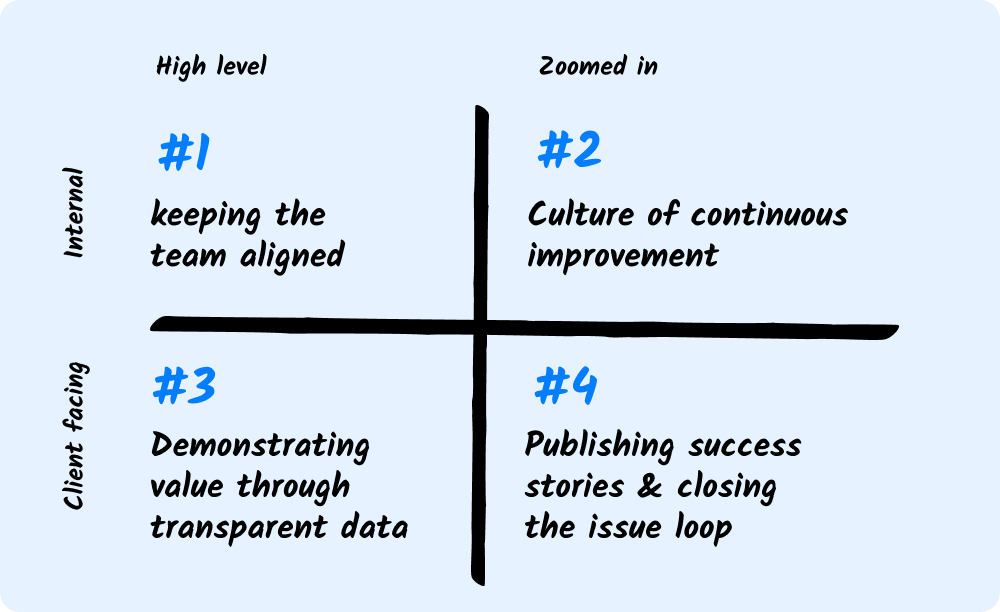
1. Keep your team on-track and inspired
Every member on your team deserves to have a sense of purpose and a clear understanding of the big picture. This increases job satisfaction; productivity grows accordingly.
But it’s not enough to rely on anecdotes and generalities. You need specific goals as targets to measure against & work towards. They must be based on tangible results.
Of course, it’s helpful to look at what your competitors are doing. But the best information about your company’s current success and future possibilities comes from the customers themselves.
By analyzing customer satisfaction data along a few KPIs, you can discover your baseline satisfaction level and set future goals based on data analysis.
All the decision-makers in your company need to remain apprised of shifts in customer feedback trends. They can’t afford to miss anything.
“If you take care of your people, your people will take care of your customers and your business will take care of itself.”
J. W. Marriott, founder of the Marriott Corporation
💡 Ways to utilize the data:
- Report CSAT and NPS survey data on your monthly scorecard.
- Set objectives for each month/quarter/year (for example, you can aim to achieve a 20% NPS increase by the end of the following quarter).
- At company meetings, share your successes and failures in meeting these objectives.
- Create team member leaderboards that track CSAT/NPS results.
2. Maintain a culture of continuous improvement
A broad look at quantitative data keeps your team on track because it provides clarity: you’re either meeting your goals or you’re failing.
But for more targeted improvement, you need to zoom in on what, exactly, customers are saying. Each new survey result tells you something important about your team and your product. If you can automate the process of reviewing this data, it will have an immediate positive impact on your team.
You can drill down on individual ratings to gain deeper insights into various facets of the customer experience.
Open-ended survey questions are especially useful: in their own words, your customers can point out strengths and weaknesses you might otherwise miss.
💡 Ways to utilize the data:
At Simplesat, we like to make CSAT and NPS results public in a Slack channel.
This automated process creates a culture of mutual accountability, and team members with especially good results get commended. (For exceptionally disappointing results, we prefer private discussions – but it also helps to have the numbers out there for everyone to see.)
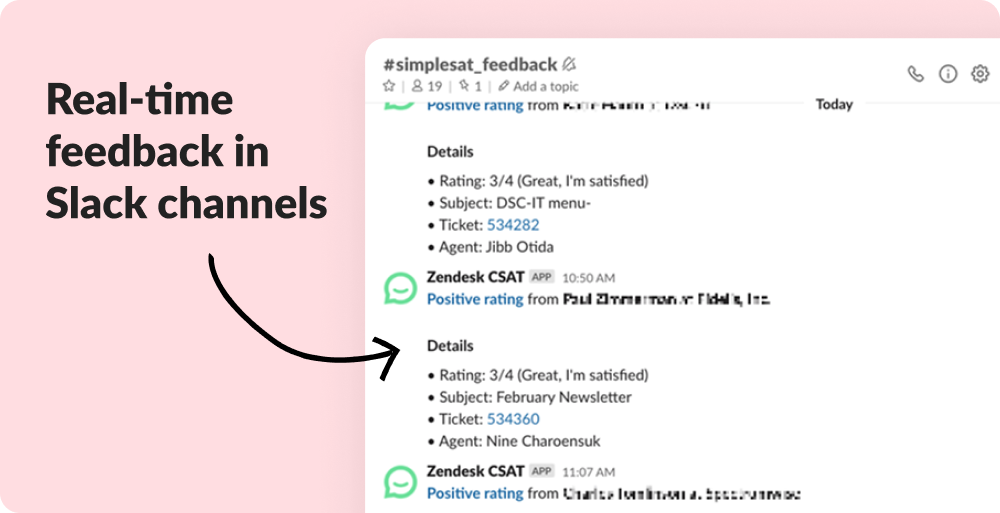
We also include feedback highlights in a monthly customer success heartbeat Basecamp post that gets shared with all team members.
3. Demonstrate value to customers/clients
However much work you put into building your brand, your reputation is still vulnerable to unflattering anecdotes (see: negativity bias) or bad first impressions. Over time, your existing customer base might get disillusioned or bored with the service they’re receiving.
You can shift the conversation by being open and proactive about sharing customer satisfaction scores and trends.
Let the numbers do the talking. Share your value and ROI with both prospective and current customers. It’s very useful to segment customers and show them data that applies to their industry or niche.
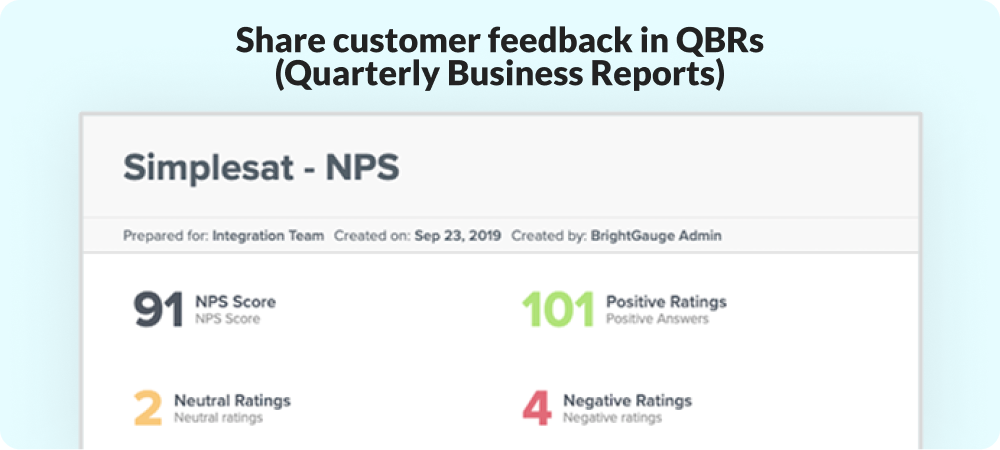
Keep your customers in the loop regarding successfully completed projects and other innovations. Show that you’re not stagnating and that you have feedback-based, actionable plans for the near and far future.
💡 Ways to utilize the data:
- Include satisfaction scores in annual or monthly reports and newsletters.
- Use QBRs (Quarterly Business Reviews) to share insights and trends.
- Include CSAT/NSP results with new feature announcements.
- Make sure the data you’re sharing is easy to parse and placed into clear context. It’s on you to put in the work to make the numbers meaningful to the customer.
Combine high-level results with some individual (zoomed-in) examples of feedback to make your reports more memorable. For example, you can include a few recent, enthusiastic reviews alongside your CSAT analytics in a monthly report.
4. Use feedback to strengthen customer relationships
Publishing qualitative feedback makes your successes more tangible. When you share positive reviews and case studies, you create a meaningful narrative that can counteract any biases or negative impressions your customers may have picked up along the way. 👍
But it’s even more important to use negative feedback as an opportunity to reach out to customers. If you can demonstrate excellent customer service in response to dissatisfaction, you will earn the trust and loyalty of your customer base.
This is called the service recovery paradox:
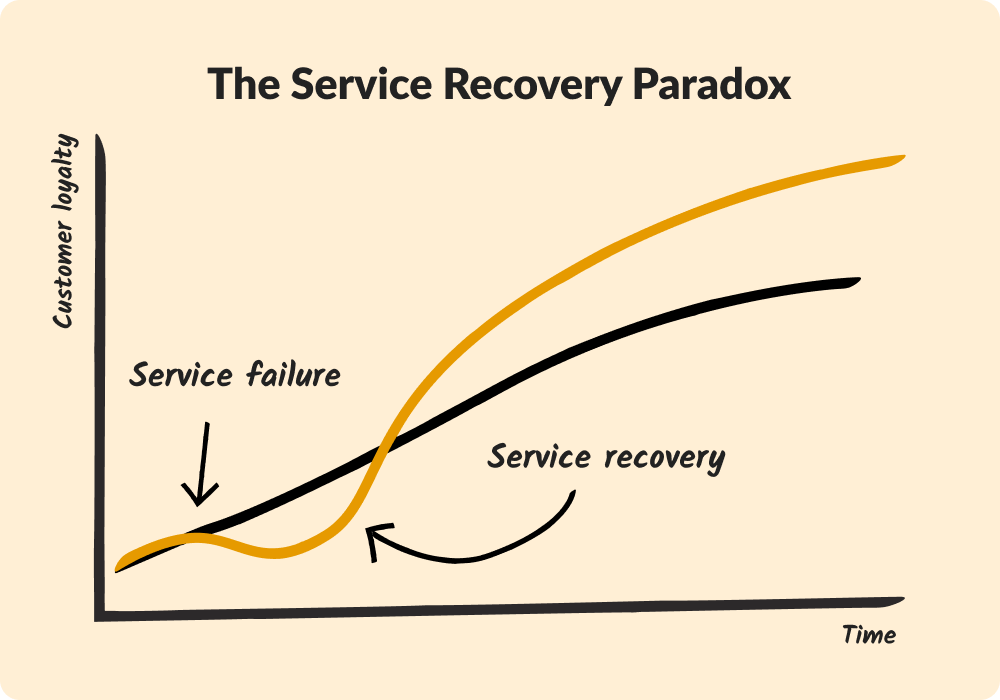
You need to make it clear that you’re listening, rather than just going through the motions of ‘good customer service’.
Automated messages won’t always cut it: stay open to the possibility of directly responding to both positive and negative feedback. In case of customer disappointment, experts need to be ready to provide hands-on help.
What are some practical approaches to using individual reviews or complaints?
💡 Ways to utilize the data:
You want to amplify all the positive feedback you receive. Use it as a basis for reaching out to prospective customers.
All the negative feedback that you get is an opportunity to build a relationship with the dissatisfied reviewer. You want to reach out to them and show that your company is ready to adapt to their needs.
Let’s delve into this deeper. How do you turn feedback into an opportunity to increase customer loyalty?
How to handle positive or negative customer feedback
Your customer support team needs to be ready to provide quick, high-quality information to anyone who takes the time to ask a question or make a suggestion.
But responsiveness isn’t enough. To fully utilize all the information you’ve collected, you need to be proactive. That is how you can stand out from the crowd.
😍 Follow up on positive feedback
Set up automated and personalized responses to positive reviews.
When a customer leaves you a positive comment in a CSAT survey…
🌟 Publish it to your site. Simplesat provides a widget that can do this automatically.
🐤 Link to your socials and encourage interaction there.
🤓 Ask the customer to leave you a Google/G2/etc. review.
Example: Our partner company, Pronto Marketing, started asking their users to leave a Google review for every 4- or 5-star CSAT rating. Over six months, their review count quadrupled.
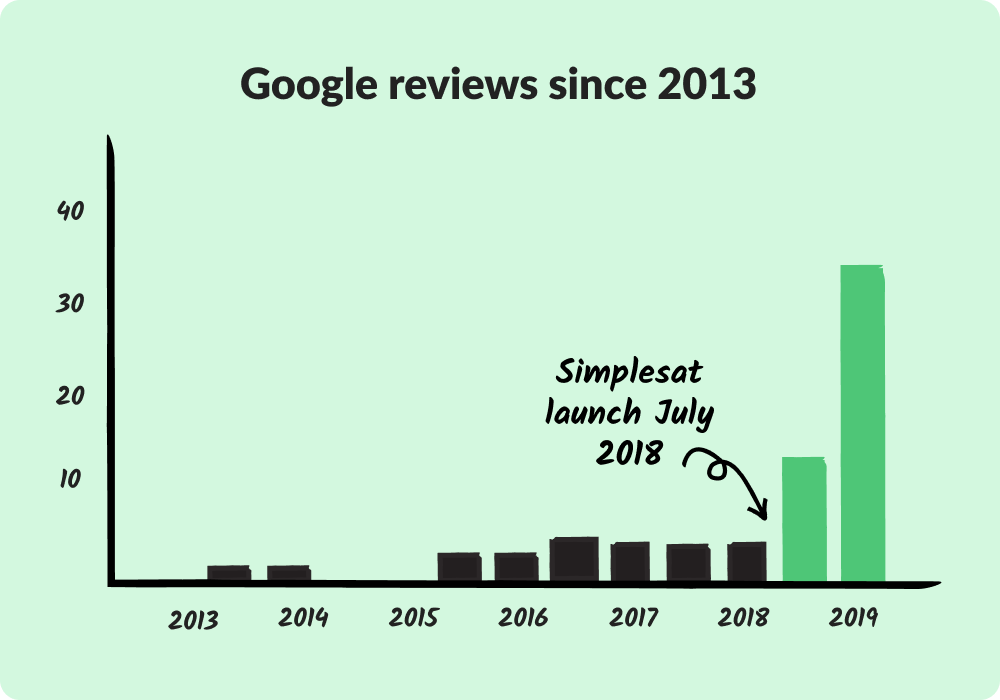
Promoters are customers who rated your company 9/10 or 10/10 on an NPS survey.
Reach out to your Promoters and…
👯♂️ Make it easy for the Promoter to recommend your product/service to a friend. It can be a good idea to offer both them and the new lead a referral discount.
✍ Ask for their customer story. Your team can follow up on it and create case studies.
🦸♀️ Again, encourage reviews and testimonials across platforms. Be direct and informal – people respond better to what feels like a direct request.
🤬 Follow up on negative feedback
According to TARP, only 4% of customers are willing to provide negative feedback when they’re dissatisfied with the product or service they’re receiving. The vast majority simply cancel instead.
Conclusions:
- The feedback you receive will always skew positive, so it’s important to highlight and focus on any negative comments.
- It’s on you to encourage your customer to share negative feedback.
When the customer informs you about a pain point that they have, you get an opportunity to build a better relationship with them.
The process is called closing the loop and it’s integral to building a service-oriented company culture. It’s one of the best ways to reduce churn.
After a customer leaves a negative review, get in touch with them immediately. Check if the reviewer has more information they’re willing to share with you, and tell them that their complaint is being processed. Contact them again as soon as you can give them a solution or workaround.
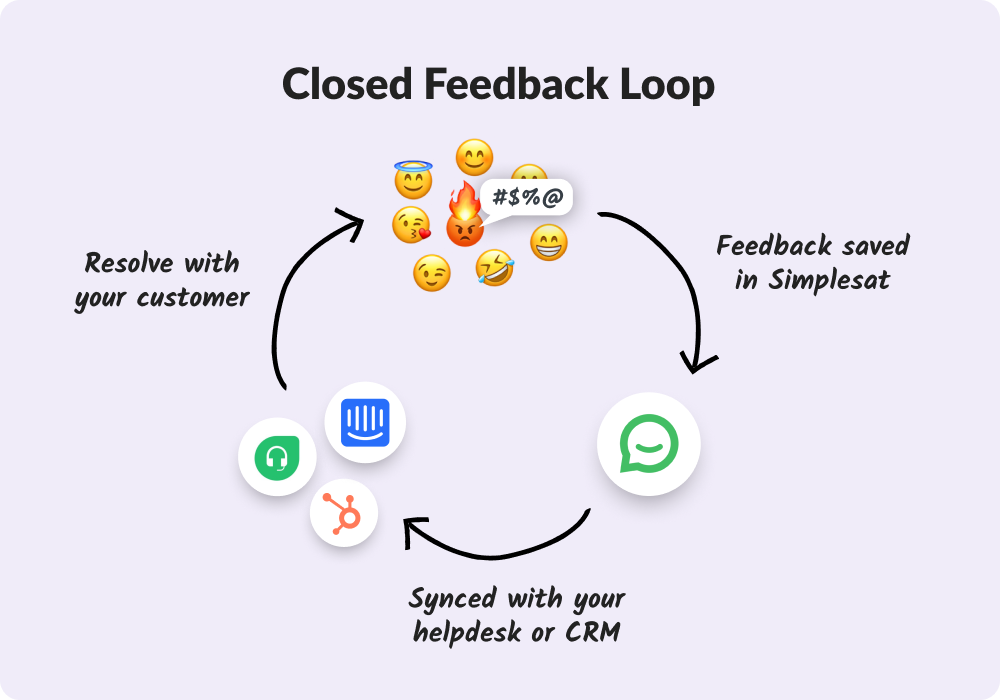
Make sure your service team is ready to respond to low CSAT ratings as soon as the ticket is closed. Per ReviewTrackers, one-third of customers expect a response to their negative review within 3 days. Sooner is better.
Specificity is important too. Even if you’re using a customer service bot, you should make it effortless for the customer to get in touch with a human who understands their complaint and has some answers prepared. 🙋♀️
You can also close the loop on customers who expressed dissatisfaction via NPS survey responses.
Customers who rated you 0-6 out of 10 on an NPS survey are called Detractors. You can get in touch with Detractors to discuss any improvements they may need. This is the best way to retain customers who plan to take their business elsewhere.
It’s crucial to close the loop even if no immediate solution is available.
For example, a common complaint among Simplesat customers is the lack of integrations for their preferred CRM. We keep careful track of who asked for which integrations, and users get notified as soon as we build what they need.
How to improve your response rate and get high-quality feedback
Customers don’t tend to like filling out surveys. When they do, they may default to giving you good scores without thinking their replies through. It’s human nature to look for the path of least resistance, and that includes saying that a customer experience was fine when it really wasn’t.
Put in effort to defeat this inertia and convince your customer/client that it’s worth their time to fill out your survey (and to do it thoughtfully and sincerely).
In our experience, the following factors help to motivate customers who wouldn’t usually offer feedback:
✍️ Compelling copy
The ideal tone and style of interactions will always depend on your industry. But as a rule, some informality is helpful: it makes you sound less robotic and encourages the customer to think about their experience.
Make it clear that you’re looking for any feedback, positive or negative, and don’t rely on automated messages if someone goes above and beyond with their comment or review.
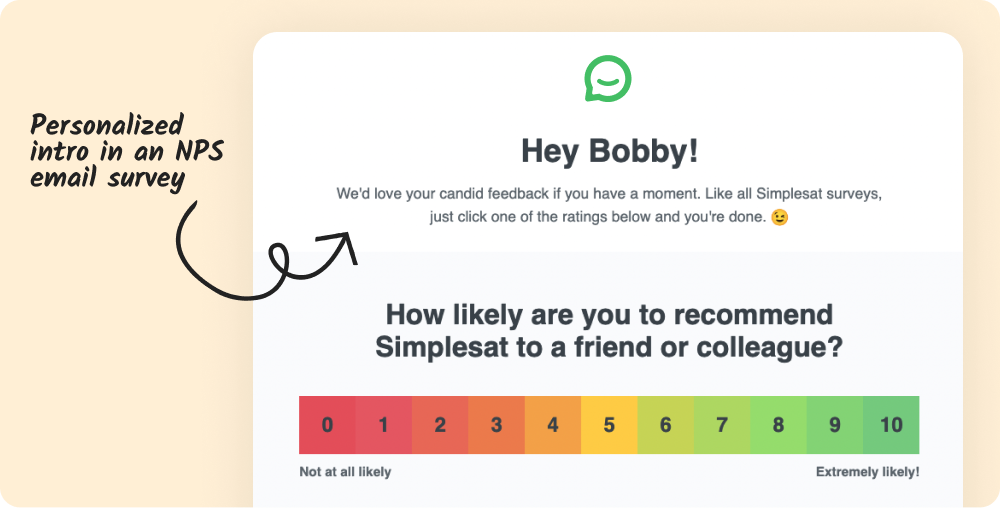
🎨 Eye-catching graphic design
Don’t neglect the visual component of the user experience. Survey design is part of our job, and we’ve noticed that visually interesting surveys receive more responses.
Animations, weird or cute icons, surprising color combinations – any daring design choice could convince the user not to click away just yet. Aesthetically pleasing and brand-appropriate visuals make it clear that the feedback you receive is important to you.
A good basic rule for customer feedback surveys: keep the text simple and easy to understand; use the design to stand out from the crowd.
📏 Appropriate rating-scale granularity
If the feedback you’re receiving isn’t informative enough, you might want to experiment with the rating scales used in your surveys.
Higher granularity adds nuance. Instead of asking customers if their experience was good/medium/bad, consider using a 1-5 or 1-10 scale. This makes it easier to pinpoint specific customer experiences – for example, you can highlight experiences that are almost (but not quite) perfect.
On the other hand, high granularity makes it a bit more taxing to fill out surveys, especially when there are multiple questions. If your response rates are low, consider using emojis and going down to three or even two options.
⏳ Good timing
Here’s something we consistently see when comparing CSAT and NPS scores from the same customer. Right after a closed ticket, people tend to rate everything highly without going into detail. Even if the interaction was unpleasant, they don’t want to get anyone in trouble. But later, in NPS surveys, the same customers are more forthcoming and objective.
Optimize your feedback data management system
You need to remain committed to analyzing and utilizing the incoming data even when circumstances change in your industry or your company. Remember, it’s crucial to avoid bottlenecks.
The following questions will help ensure you have a robust system in place for making the most out of the feedback you receive.
1. Have you maximized automation?
The data you collect has to be a part of your everyday workflow. To make that easier, automate processes wherever possible.
Share all customer feedback data with your team, and categorize it from the get-go. At the same time, it’s important to have a smooth, semi-automated system for feedback-based client interactions.
Be mindful of scalability and build a sturdy infrastructure for processing all incoming data. That will let you avoid pile-ups and delays as your company grows or changes direction.
2. Is your team learning from every mistake?
Customer feedback creates an opportunity for communication. Unfortunately, there is no formula that will work with every customer, which means some setbacks are inevitable.
Reaching out to unhappy respondents requires delicacy and patience. Asking happy customers for reviews and testimonials can go awry too – you may come across as pushy or demanding.
You and your team have to be prepared to experiment. Learn from failed customer interactions and always strive for improvement.
3. Are you doing all you can to segment the incoming data for clarity?
The customer responses you send out will depend on whether the feedback was positive, ambivalent, or negative. But there are other factors to take into account.
When you group your users by niche, location, company size, recent activity, etc, you can:
- Identify trends and make fact-based decisions about future growth.
- Communicate with customers in a more personalized way, even when that communication is automated (for example, you can use different email templates for end-users vs. decision-makers).
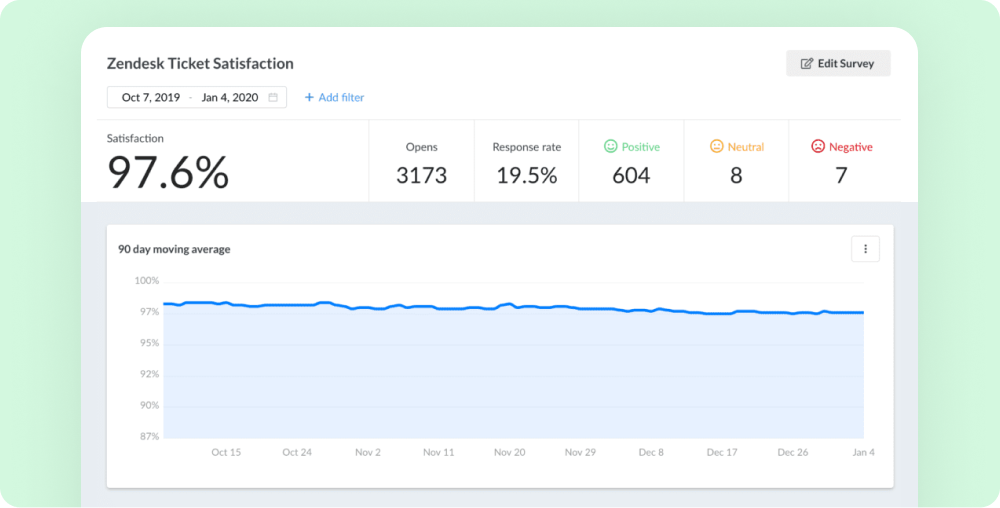
4. Are you closing every loop as efficiently as possible?
When you’re closing the loop with a dissatisfied customer, it’s important to understand where they’re coming from. You don’t want them to have to repeat their problem to several team members before it gets resolved.
Make it easy to look up any individual customer’s feedback history, along with any support requests they made in the past. (At Simplesat, we add notes for context to all our customer ratings, which makes this easier.)
Always double-check whether you’ve resolved the crux of the issue they struggled with. And keep track of unclosed loops. With each new release and product development breakthrough, you may get the chance to improve a customer’s opinion of your brand.
Every decision you make needs to be guided by customer feedback!
The main goal of good customer feedback management is to increase customer loyalty.
Your customers can easily leave after a single negative experience… and many do. But if you remain committed to taking feedback seriously, there’s a higher likelihood that your customers will stick with you.
By sharing your successes and encouraging reviews, you can reach new audiences with information about your exemplary product and service. This is more persuasive than relying on ads alone. With a loyal and dedicated customer base, it is easy to build your brand recognition and keep expanding it.
Your company’s not perfect. You’ll keep making mistakes. But if you maintain transparency and show your customers that you are constantly improving, you will earn their good faith. Make it clear that you value their judgment, and they’ll be willing to help you grow. 🌱
Build a workflow that relies on customer feedback every step of the way. Instead of falling back on routine and guesswork, base your decisions on solid truths. With a data-led, dynamic approach to improvement, your brand will flourish.
It takes time and experimentation to find the best approach to using the feedback your customers provide. This isn’t a one-and-done project: you’ll keep learning new things about your customer base and what they expect from you. You have to stay committed to trying new things.
We hope this course will help you on that journey.
